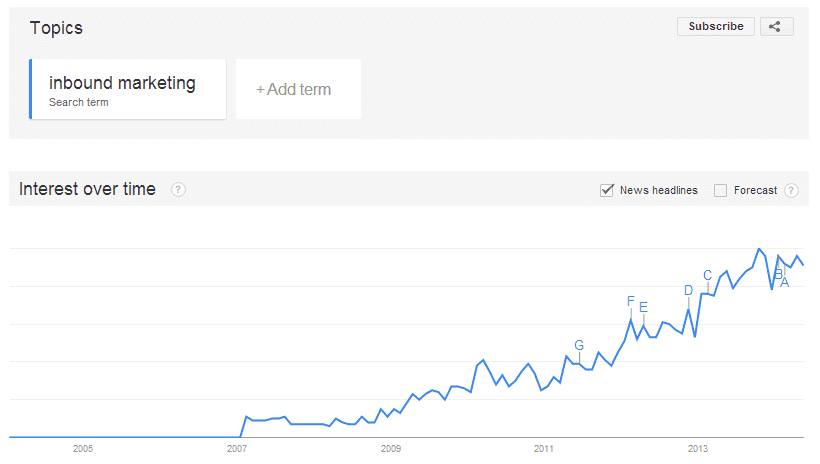Inbound has literally taken off since it stepped on the scene. You've probably seen it mentioned online, heard about it at conferences, and maybe even done some research yourself.
And you're not alone - the word is out about Inbound Marketing, and people are looking to find out more.
We can see this clearly evidenced on Google trends, which shows an incredible spike in search interest for the term "Inbound Marketing" over the past seven years:

As any star rises in an industry, there is bound to be much talk about the pros and cons of the newest darling. Inbound has certainly earned it's reputation as being a solid lead generation and revenue boosting methodology, but it has also accumulated some rumors to it's name along the way.
Some myths you hear about Inbound Marketing are true - the stories of astronomical traffic growth, of enviable conversion rate increases, of revenue spikes - those can all be validated by different sources, time and again.
But some myths are just that: stories that have been perpetuated by both Inbounders and Inbound opponents, which don't paint an accurate picture of Inbound's implementation or capabilities.
They say there are two ways to handle a rumor: to ignore it, or to tackle it head on. I think these myths have been ignored plenty long enough, and it's time we clarify why they're not quite accurate.
So, if you're somewhat new to the Inbound world and have been wondering what is and isn't true about it, check out these Inbound myths, both positive and negative, debunked:
1. Inbound works for every one, every time
As an Inbound marketer, it can be tempting to assert that Inbound works for all businesses. Afterall, what could possibly go wrong with creating content, building a digital presence, and optimizing communication channels to speak to targeted personas?
While none of these strategic puzzle pieces will harm your business, the danger lies in assuming that Inbound is a universal end all solution.
For the small local business, Inbound is a great option. But let's be clear that it's not the only option. If you're seeing great returns on movie ads, or mailer inserts - keep it up. Try implementing some complimentary Inbound tactics, and gauge whether they could eventually offset the need for those traditional efforts.
The truth is that there is no marketing tactic that will transform every business in every context. The trick is to first think of Inbound as a supplement to any current efforts which are working, and assess both of their effectiveness from there.
2. You need to be on every social media network
Perhaps one of the biggest apprehensions many smaller business owners have about jumping into the social media pool is the percieved depth. Indeed, a quick Wikipedia search tells us there are a plethora, or even innundation, of networks out there.
However, when Inbound is correctly implemented, there is absolutely no need for a business to be active on more than a handful of networks. Constructing buyer personas helps the business determine where their intended customers are seeking information and spending time, thus eliminating the need to run around updating countless profiles.
If you've been shying away from social media or Inbound for fear of drowning in updates, take a minute to consider which networks really matter to your audience.
3. Inbound is a "one and done, set it and forget it" solution
We all like an easy fix, turn key solution. Unfortunately, in marketing there really is no such thing.
Online ads have to be monitored, content has to be edited, websites have to be updated. In this sense, Inbound is really no different than other marketing methodologies - it requires careful supervision, optimization, and measurement.
If you're looking for a set it and forget it option, I'd advise you to steer your sails far from Inbound island. This methodology requires commitment and time, but the treasure you'll find is well worth the journey.
(Bonus points if you can come up with an even cheesier metaphor than that.)
4. Inbound only works on younger, tech savvy audiences
This is one of the most common misconceptions surrounding Inbound marketing: since it's based online, it's only effective for GenY and beyond.
If someone has told you this, I want you to step away from the computer, find that individual, and kick them in the pants - because they've fed you a falsehood.
This myth is false for two reasons.
First, Inbound is much more than an online experience. It encompasses all touch points with a customer, from prospect to lead to customer to advocate. It's not just about capturing their attention, it's about fostering a relationship with them far after the purchase. By no means is this exclusive to the online realm - advocacy can be built via whatever medium best reaches the customer.
Second, you shouldn't discount the tech savvy of the 50+ demographic. Baby boomers now spend more time online than watching television, and are significantly decreasing their time reading newspapers and listening to the radio.
Going back to myth 1, please don't take this as a push to abandon your traditional efforts entirely. Remember to do what works for you, just don't write off Inbound because of your assumptions about older audiences.
5. Inbound displaces sales reps
Among those in greatest opposition to Inbound, traditional sales reps are leading the pack. And with good reason: countless articles and discussions have explored the idea that Inbound eliminates the need for traditional prospecting and nutruting, and can effectively automate the process with technology.
To be clear, yes Inbound can certainly shorten the sales cycle and minimize rep time spent converting leads. But this is by no means the end of the sales rep.
Shoot back to myth 4: Inbound isn't just about grabbing attention, it's about effectively communicating with self identifying relevant audiences, and building long term relationships with those would or will be customers. We need sales reps for all parts of this journey from initial touch point to closing the deal to remaining present after the sale.
Whether you're a sales rep or a business owner, rest assured that Inbound does not spell the death of your salesforce, just a transformation.
What other myths have you heard about Inbound? Which rumors, good or bad, have you found to be true? We'd love to hear your two cents on Facebook and X / Twitter!

